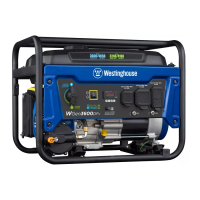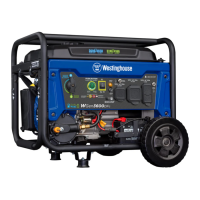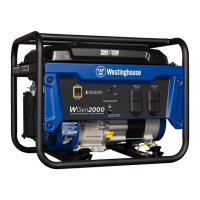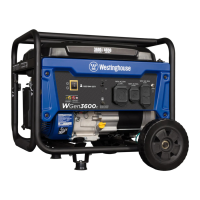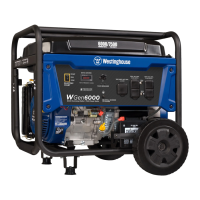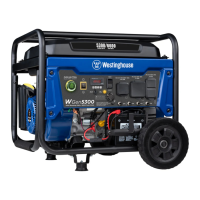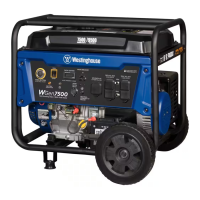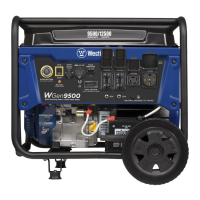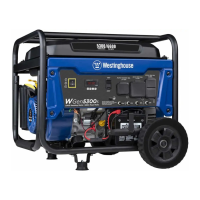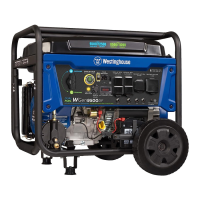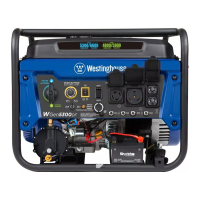Do you have a question about the Westinghouse WGen3600DF and is the answer not in the manual?
Information, illustrations, and specifications are based on the latest available data.
Section for recording purchase details like date, model number, and serial number.
Instructions and form for registering the generator for warranty coverage.
Defines important safety terms like DANGER, WARNING, CAUTION, and NOTICE used in the manual.
Provides a visual guide and explanation for various safety alert symbols used on the generator and in the manual.
Essential rules for safe operation, covering electrical hazards, fuel handling, and environmental conditions.
Identifies and explains the safety labels and decals found on the generator unit.
Detailed guidelines for safe handling of gasoline and propane, including storage and refueling precautions.
Lists all the components and accessories included with the generator shipment.
Instructions for verifying the contents of the wheel kit accessories box.
Step-by-step instructions for attaching the wheels and mounting feet to the generator frame.
Procedure for securely connecting the positive and negative battery cables to the generator.
Overview of the main components and physical features of the WGen3600DF generator.
Detailed explanation of each control, indicator light, and outlet on the generator's control panel.
Covers essential pre-operation checks including location, weather, load disconnection, grounding, and altitude considerations.
Information on selecting appropriate extension cords and using the provided Westinghouse power cord.
Instructions for checking and adding engine oil, and general advice on fluid and fuel management.
Steps to pair and program the remote start key fob with the generator for wireless operation.
Procedure for safely adding unleaded gasoline to the generator's fuel tank, including fill level guidance.
Instructions for connecting a propane tank, including safety checks and hose connections.
Guidance on how to safely switch between gasoline and propane fuel sources while the generator is running.
Step-by-step guide for starting the generator using gasoline, propane, recoil, remote, or push-button methods.
Procedures for safely stopping the generator during normal operation and in emergency situations.
Owner-performed and dealer-performed maintenance tasks and recommended intervals for the generator.
Covers engine oil specifications, checking the oil level, and procedures for adding engine oil.
Step-by-step instructions for draining and refilling the engine oil, including proper disposal.
Procedure for cleaning the air filter element, including frequency and cleaning solution recommendations.
Guide for inspecting, cleaning, and replacing the spark plug, including gap specifications and recommended plugs.
Procedure for checking and adjusting valve lash when the engine is cold, with specified clearances.
Instructions for maintaining battery charge, including charging frequency and method.
Guidelines for cleaning air inlets, cooling fins, and the general exterior of the generator.
Steps for preparing the generator for storage, including fuel draining and protection from elements.
Diagnoses and solutions for issues where the generator runs but does not produce electricity.
Addresses problems with inconsistent engine speed and RPM fluctuations.
Troubleshooting steps for when the generator unexpectedly shuts off during operation.
Covers causes and solutions for the generator failing to start or shutting down during the starting process.
Explains normal frost formation and potential issues with propane supply due to temperature changes.
Addresses propane leaks and safe handling procedures, including identifying and rectifying smells.
Troubleshooting steps for issues related to engine performance or stalling when using propane as fuel.
Information, illustrations, and specifications are based on the latest available data.
Section for recording purchase details like date, model number, and serial number.
Instructions and form for registering the generator for warranty coverage.
Defines important safety terms like DANGER, WARNING, CAUTION, and NOTICE used in the manual.
Provides a visual guide and explanation for various safety alert symbols used on the generator and in the manual.
Essential rules for safe operation, covering electrical hazards, fuel handling, and environmental conditions.
Identifies and explains the safety labels and decals found on the generator unit.
Detailed guidelines for safe handling of gasoline and propane, including storage and refueling precautions.
Lists all the components and accessories included with the generator shipment.
Instructions for verifying the contents of the wheel kit accessories box.
Step-by-step instructions for attaching the wheels and mounting feet to the generator frame.
Procedure for securely connecting the positive and negative battery cables to the generator.
Overview of the main components and physical features of the WGen3600DF generator.
Detailed explanation of each control, indicator light, and outlet on the generator's control panel.
Covers essential pre-operation checks including location, weather, load disconnection, grounding, and altitude considerations.
Information on selecting appropriate extension cords and using the provided Westinghouse power cord.
Instructions for checking and adding engine oil, and general advice on fluid and fuel management.
Steps to pair and program the remote start key fob with the generator for wireless operation.
Procedure for safely adding unleaded gasoline to the generator's fuel tank, including fill level guidance.
Instructions for connecting a propane tank, including safety checks and hose connections.
Guidance on how to safely switch between gasoline and propane fuel sources while the generator is running.
Step-by-step guide for starting the generator using gasoline, propane, recoil, remote, or push-button methods.
Procedures for safely stopping the generator during normal operation and in emergency situations.
Owner-performed and dealer-performed maintenance tasks and recommended intervals for the generator.
Covers engine oil specifications, checking the oil level, and procedures for adding engine oil.
Step-by-step instructions for draining and refilling the engine oil, including proper disposal.
Procedure for cleaning the air filter element, including frequency and cleaning solution recommendations.
Guide for inspecting, cleaning, and replacing the spark plug, including gap specifications and recommended plugs.
Procedure for checking and adjusting valve lash when the engine is cold, with specified clearances.
Instructions for maintaining battery charge, including charging frequency and method.
Guidelines for cleaning air inlets, cooling fins, and the general exterior of the generator.
Steps for preparing the generator for storage, including fuel draining and protection from elements.
Diagnoses and solutions for issues where the generator runs but does not produce electricity.
Addresses problems with inconsistent engine speed and RPM fluctuations.
Troubleshooting steps for when the generator unexpectedly shuts off during operation.
Covers causes and solutions for the generator failing to start or shutting down during the starting process.
Explains normal frost formation and potential issues with propane supply due to temperature changes.
Addresses propane leaks and safe handling procedures, including identifying and rectifying smells.
Troubleshooting steps for issues related to engine performance or stalling when using propane as fuel.
| Starting Watts (Gasoline) | 4650 |
|---|---|
| Running Watts (Gasoline) | 3600 |
| Running Watts (Propane) | 3240 |
| Fuel Type | Gasoline/Propane |
| Engine Type | 4-Stroke OHV |
| Engine Displacement | 212cc |
| Gasoline Tank Capacity | 4 Gallons |
| Frequency | 60 Hz |
| Noise Level | 68 dBA |
| Wheel Kit | Yes |
| Handle Kit | Yes |
| Propane Run Time at 50% Load | 11 hours |
| Voltage | 120V |
| AC Outlets | 1x 120V 20A (5-20R), 1x 120/240V 30A (L14-30R) |
| Starting System | Electric / Recoil |
